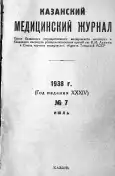Treatment of corneal ulcers with trachoma Iontophoresis
- Authors: Epshtein E.D.1
-
Affiliations:
- Eye clinic (director prof. A. N. Murzin) Kazan State Institute for Advanced Medical Studies V. I. Lenin
- Issue: Vol 34, No 7 (1938)
- Pages: 707-711
- Section: Articles
- URL: https://ogarev-online.ru/kazanmedj/article/view/57739
- DOI: https://doi.org/10.17816/kazmj57739
- ID: 57739
Cite item
Full Text
Abstract
The problem of treating trachoma cannot be considered solved, and therefore there is a constant desire to find new ways to treat this disease and its complications. One of the relatively new methods is iontophoresis treatment of trachoma. This method of treatment consists in injecting drug ions through an electric current through intact tissues. The method being analyzed is based on electrolysis. When salts, acids or bases dissolve in distilled water, each molecule decomposes into ions, some of which are positively charged (cations), others are negatively (anions), and the weaker the solution, the more molecules decompose into ions, as they say, dissociates. When such a dissociated solution is included in the direct current circuit, the ions start to move, and the cations move to the negative pole, and the anions to the positive pole. This ability of the ion to move from the charged pole of the same name with it is used to introduce a medicinal substance into the body by means of an electric current. Ions of copper, zinc, atropine and other alkaloids and metals are introduced into the eye from the positive pole; ions of iodine, salicylic acid, i.e., halogens, acid radicals, are introduced into the eye from the negative pole. Korenevich, Ruata, Bonvech, Dolganov, Malkin, Kolenko, Erlanger, Korn and others point to good results of trachoma treatment with iontophoresis. These authors treated the trachomatous conjunctiva with iontophoresis of copper and zinc and obtained favorable results in terms of reducing the infiltration and resorption of follicles. Erlanger, recommending this method of treatment, writes that in the treatment of trachoma and. f. you need to be patient, you do not need to use large doses, the session should not last more than 2 minutes and the current strength should not exceed 2 MA, and, finally, you need to change medications. There are few observations on the treatment of ulcerative processes of the cornea in trachoma, but encouraging results have been obtained in these few works (Belsky, Erlanger). The question of the treatment of diseases of the cornea of non-trachomatous origin by iontophoresis has been sufficiently highlighted in the literature from the positive side (Wirtz, Erlanger, Birkhaizer, Kryukman, Korotnev, Ptashnik, Luzhinsky, Ruatha, Bonvech, Dolganov, Dolgikh, Kolenko).
Keywords
Full Text
##article.viewOnOriginalSite##About the authors
E. D. Epshtein
Eye clinic (director prof. A. N. Murzin) Kazan State Institute for Advanced Medical Studies V. I. Lenin
Author for correspondence.
Email: info@eco-vector.com
Russian Federation
References
- Бельский, Сов. вести, офт., т. 4, 1934
- Бельский, Труды Всеукраин. съезда офт, 1931.
- Он же, Известия госуд. Сеченовск. ин-та, т. 2, 1928,
- Бонвеч, Арх. офт., т. 4,1926.
- Бродерзон, Ионофорез, 1927
- Богданов и Долгих, Русск. офт. журнал, т. 10, 1929.
- Бруштейн, Руков. по физ. методам лечен., 1928.
- Воробейчиков, Сов. вести, офт., т. 2, 1933.
- Донин, Русск. офт. журн., т. 13, 1931.
- Коленько, Труды Всеукраинск. съезда офт., 1931.
- Корн, Вопросы трахомы, сборы. 3 — 4, 1934.
- Лужинский, Русск. офт. журн., т. 6, 1927.
- Малкин, Русск. офт. журн., т. 13, 1931.
- Озимин, Русск. офт. журн, т 14, 1931.
- Пташник, Арх. офт., т. 7, 1930.
- Протопопов, Арх. офт., т. 6, 1929.
- Эрлангер, Арх. офт. т. 8, 1931.
- Юзефова и Кроль, Арх. офт., т. 8, 1931.
- Ruata, Arch. d‘ophtalm. Bd. 45, 1928
- Birnhäiiser, Kl. M. f. A., Bd. 67, 1921.
Supplementary files






